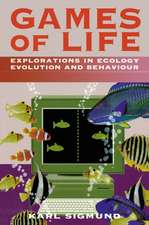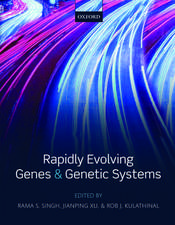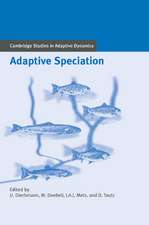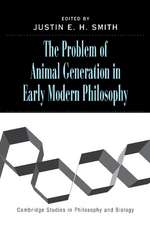Evolution: An Evolving Theory
Traducere de T. Reimer Autor Charles Devillers, Jean Chalineen Limba Engleză Paperback – 16 apr 2012
Preț: 446.49 lei
Preț vechi: 551.23 lei
-19% Nou
Puncte Express: 670
Preț estimativ în valută:
85.45€ • 92.78$ • 71.77£
85.45€ • 92.78$ • 71.77£
Carte tipărită la comandă
Livrare economică 18-24 aprilie
Preluare comenzi: 021 569.72.76
Specificații
ISBN-13: 9783642770241
ISBN-10: 364277024X
Pagini: 268
Dimensiuni: 155 x 235 x 14 mm
Greutate: 0.38 kg
Ediția:Softcover reprint of the original 1st ed. 1993
Editura: Springer Berlin, Heidelberg
Colecția Springer
Locul publicării:Berlin, Heidelberg, Germany
ISBN-10: 364277024X
Pagini: 268
Dimensiuni: 155 x 235 x 14 mm
Greutate: 0.38 kg
Ediția:Softcover reprint of the original 1st ed. 1993
Editura: Springer Berlin, Heidelberg
Colecția Springer
Locul publicării:Berlin, Heidelberg, Germany
Public țintă
GraduateDescriere
Is
evolution
predictible?
Taking
into
account
the
results
ofsuch
diverse
disciplines
of
natural
sciences
as
e.
g.genetics
embryology,
ecology,
palaeontology
on
the
thresholdof
the
coming
century,
the
authors
stretch
out
their
ideasfor
discussing
this
question.Charles
Devillers,
biologist,
and
Jean
Chaline,palaeontologist
and
geologist,
developed
a
new
assessment
ofthe
historic
framework
of
evolution,
based
on
theirlongterm
experiences
in
scientific
research,
also
includingphilosophical
aspects
to
life.
They
aimed
the
book
at
apublicreceptive
to
problems
of
the
origin
and
evolution
oflife
and
especially
of
mankind
to
teachers
and
scientists
ofvarious
topics
in
the
sciences
of
life,
Earth
and
theUniverse.
Cuprins
The
Theory
of
Evolution
—
The
19th
Century
Concepts.-
I:
Biological
Evolution.-
1
What
Is
Biological
Evolution?.-
Development
of
the
Concept
of
Evolution.-
Defining
Biological
Evolution.-
Is
the
Theory
of
Evolution
a
Scientific
Theory?.-
2
The
Modern
Theory
of
Evolution:
The
Synthetic
Theory.-
Some
Stages
in
the
History
of
Evolution.-
What
Does
the
Synthetic
Theory
Tell
Us?.-
Artificial
vs
Natural
Selection.-
Artificial
Selection:
Man’s
Greatest
Biological
Experiment
—
From
Wolves
to
Dogs.-
How
Do
Natural
and
Artificial
Selection
Differ?.-
Natural
Selection
at
Work:
Competition.-
Selection
and
Chance
in
the
Survival
of
Organisms.-
II:
The
Message
of
Nature
Today
—
The
Evolutionary
Mechanisms.-
3
Genetic
Material
and
Programmes.-
The
Structure
of
the
Genetic
Material:
DNA
and
Genes.-
How
Can
the
Genetic
Material
Change?.-
The
Neutralist
Theory
of
Evolution.-
Mutation
and
Chance.-
Functioning
of
the
Genetic
Material.-
Genetic
Programmes
in
the
Synthetic
Theory.-
The
“New”
Genetics.-
Molecular
Evolution.-
4
From
Egg
to
Adult:
Development.-
Relationship
Between
Development
of
the
Individual
and
Its
Evolutionary
History.-
Is
Development
the
Resume
of
Evolutionary
History?.-
Does
Development
Create
Evolutionary
History?.-
Why
Has
the
Synthetic
Theory
Not
Taken
the
Development
Data
into
Account?.-
What
is
the
Development
of
an
Organism?.-
What
Is
the
Role
of
the
Genes
in
Development?.-
Is
Development
Controlled
Only
by
Genes?.-
Evidence
for
the
Role
of
Genes
in
Development.-
Atavism:
The
Reappearance
of
Lost
Features.-
How
Does
Development
Intervene
in
Evolution?
From
the
Genetic
Programme.-
Through
Development
to
the
Final
Organism.-
5
Adaptation:
The
Driving
Force
or
a
Result
of
Evolution?.-
What
Is
Adaptation?
How
Can
Different
Organisms.-
Adapt
to
the
Same
Conditions
of
Life?.-
Remarkable
Adaptations.-
“Quality”
of
Adaptations.-
Adaptation
Does
What
It
Can.-
6
A
First
Resumé:
Organisms,
Selection,
and
Adaptation.-
Not
Everything
Is
Possible
in
Evolution,
Even
with
Time.-
Genetic
Programming
Works
Economically.-
Genetic
Programmes
and
Development.-
Hierarchy
in
the
Construction
of
Organisms.-
How
Does
a
Leg
Form?
A
Classical
Problem
of
Evolution.-
Continuity
or
Discontinuity
in
Evolution.-
III:
The
Message
of
Fossils
from
the
Palaeontological
Record.-
7
The
Formation
of
Species.-
The
Street,
an
Observation
Point
for
Variation.-
What
Is
a
Population
or
a
Species?.-
Are
Two
Species
Easily
Distinguished
Between?.-
The
Domestic
Mouse
and
the
Field
Mouse.-
The
Sibling
Drosophilas
of
Central
and
South
America.-
What
Is
the
Purpose
of
Reproductive
Isolation?.-
In
Mice,
Proliferation
Outweighs
Aggressiveness.-
Variation
Within
Species.-
Variation
Between
Individuals.-
Variation
Between
Groups.-
The
Origin
of
Species.-
Speciation
by
Geographical
Isolation.-
Speciation
Without
Geographical
Isolation.-
May
We
Observe
Species
Forming
at
Present?.-
A
Fundamental
Concept,
the
Hierarchy
of
Organizational.-
Levels
in
Organisms,
the
“Keyboard
of
Living
Matter”.-
8
The
Historical
Framework
of
Evolution.-
What
Are
Time
and
Space
for
Biologists
and
Palaeontologists?.-
A
Thought
Experiment.-
The
History
of
Life.-
The
Origin
of
Life
on
Earth.-
9
The
Species
in
the
Course
of
Geological
Time.-
What
Makes
Palaeontological
Species
Special?.-
Species
and
the
Continuity
of
Generations
Through
Time:
The
Lineage.-
What
Is
the
Life
Span
of
a
Lineage?.-
A
Special
Model
of
Speciation
by
the
“Bottleneck
Effect”.-
What
Will
Become
of
Lineages
After
Their
Formation?.-
A
Mechanism
of
Evolutionary
Change:
Chronological
Shifts
in
Development.-
A
Global
Species
Concept.-
10
From
Species
to
Body
Plans.-
How
Did
the
Major
Body
Plans
Form:
By
Micro-
or
Macroevolution?.-
Chronological
Shifts
in
Development:
A
Mechanism
for
Major
Evolutionary
Change.-
Evolution
Within
the
Major
Body
Plans.-
11
Is
Evolution
Continuous
or
Discontinuous?.-
Do
Species
Form
Gradually
or
by
Abrupt
Discontinuities?.-
The
Gradual
Model
of
the
Synthetic
Theory:
A
Revision
of
Concepts.-
Radiations
and
Extinctions.-
Synthesis
of
Evolutionary
Patterns:
A
Spatial
and
Temporal
Model
of
Evolution.-
12
Is
Evolution
Predictable?.-
Are
There
Any
Laws
of
Biological
Evolution?.-
Does
Chance
Intervene
in
Evolution?.-
Can
We
Talk
About
“Progress”
in
Evolution?.-
13
A
Second
Resume:
From
Speciation
to
the
Formation
of
the
Major
Body
Plans.-
Redefining
the
Species
Concept.-
Reconsidering
the
Concept
of
Speciation.-
The
Models
of
Speciation.-
Micro-,
Macro-,
and
Megaevolution.-
Determinism
and
Chance
in
Evolution.-
IV:
A
New
Approach
to
Human
Evolution.-
14
A
Particular
Type
of
Evolution
—
Human
Evolution.-
“Man,
This
Unique
Being”.-
“Renaturalized”
Man.-
Our
Close
Cousins
in
the
Zoo.-
What
Do
We
Know
About
the
Bipedal
Apes?.-
What
Do
We
Know
About
the
History
of
Man?.-
What
Are
the
Implications
of
Human
History
on
the
Theory
of
Evolution?.-
What
Are
the
Stages
of
Development
of
the
Human
Psyche?.-
Is
Man
Continuing
to
Evolve?.-
Are
There
Human
Races?.-
Can
We
Measure
Human
Intelligence?.-
V:
The
Future
of
the
Theory
of
Evolution.-
15
What
Will
Become
of
the
Theory
of
Evolution
in
the
Year
2000?.-
16
Epilogue:
What
Has
Become
of
the
History
of
the
Giraffe
and
Its
Neck?.-
Appendices.
















